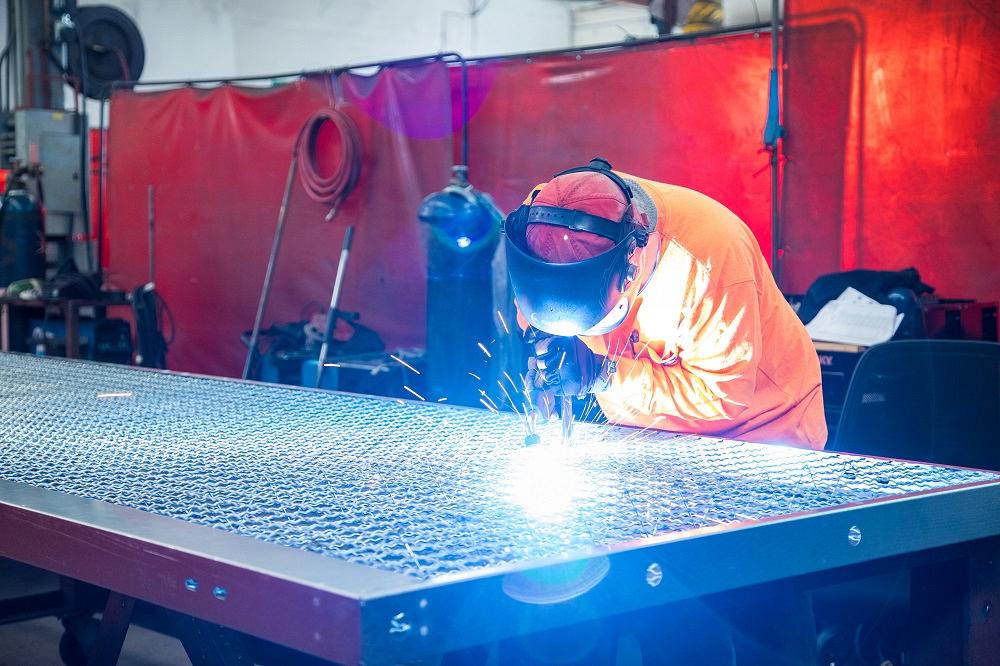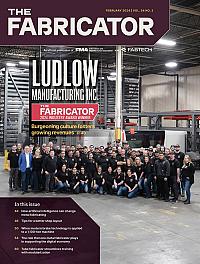Editor-in-Chief
- FMA
- The Fabricator
- FABTECH
- Canadian Metalworking
Categories
- Additive Manufacturing
- Aluminum Welding
- Arc Welding
- Assembly and Joining
- Automation and Robotics
- Bending and Forming
- Consumables
- Cutting and Weld Prep
- Electric Vehicles
- En Español
- Finishing
- Hydroforming
- Laser Cutting
- Laser Welding
- Machining
- Manufacturing Software
- Materials Handling
- Metals/Materials
- Oxyfuel Cutting
- Plasma Cutting
- Power Tools
- Punching and Other Holemaking
- Roll Forming
- Safety
- Sawing
- Shearing
- Shop Management
- Testing and Measuring
- Tube and Pipe Fabrication
- Tube and Pipe Production
- Waterjet Cutting
Industry Directory
Webcasts
Podcasts
FAB 40
Advertise
Subscribe
Account Login
Search
What makes a job shop business stand out to a buyer?
Understanding automated material movement is the first step in eliminating nonvalue-added activity
- By Dan Davis
- February 13, 2024
- Article
- Shop Management

A metal fabricating company that demonstrates the ability to manufacture specialty components for customers will stand out as an attractive candidate for acquisition. Industrial Succession Group
After years of watching HGTV, we all have a sense of what can add value to a single-family home that ultimately will hit the market. Spruce up the curb appeal. Modernize the kitchen. Hit the walls with some new paint. It’s not too complicated.
But can the same be said for a metal fabricating business? The changes aren’t as simple, but they are possible with the right plan and commitment.
Hundreds of small business owners are finding this out as they look to leave the chaos of metal fabricating and retire to a quieter lifestyle. Jules Brenner founded Industrial Succession Group (ISG) in 2020 with the intent of purchasing small manufacturing companies in Southern California from owners looking to make a transition out of the business. Brenner said the density of small to medium-sized manufacturing companies in the area and the number of company owners looking to step away from their businesses have created quite the opportunity for potential acquisitions.
ISG purchased American Sheet Metal (ASM), Anaheim, Calif., in 2022. In the months since the purchase, ISG has helped ASM to refocus on its core market, producing metal parts for the local construction and infrastructure projects, and formalize its systems. ISG acquired Pendarvis Manufacturing, also in Anaheim, Calif., in 2023 and relaunched it as Pen Manufacturing later in the year. Pen Manufacturing fabricates metal parts for the many original equipment manufacturers in the area.
Brenner said that the full ownership transition time for ASM took about six months. With the Pen Manufacturing acquisition, ISG only needed about eight weeks for the people and systems to be put in place.
“California is one of those states where many people are moving out to other states, like Texas and Idaho, and that trend has not stopped,” Brenner explained. “Business owners move a lot slower than someone just working a job where they could tell the employer that they want to work remotely. But those business owners might be looking to get out as well. That’s where we are seeing a lot of activity.”
Meanwhile, ISG continues to look for companies, but not just any manufacturing operations. Like any other prudent investor, Brenner said his company looks for certain traits in a firm that show it can thrive with the right investments. While his firm can’t buy every promising metal fabricating company, Brenner offered some insight into what he believes makes a business stand out as a potential investment opportunity. These observations can help company owners who might be looking to leave the business to get their organizations ready for a possible sale.
1. Gross Margins
The first thing any likely buyer of a business will want to know is what companies make up the customer base. A company owner is unlikely to share that information in the initial stages of conversation, but that doesn’t mean a reasonable assessment can’t be made by looking for clues elsewhere.
For Brenner, that potential answer lies in the company’s gross margin. For instance, if the owner reports really high gross margins, Brenner said he can surmise that the company is offering highly skilled work or quick turnaround for a demanding customer, like Boeing, considering the amount of aerospace work taking place in Southern California. If the reported gross margin is not as high as expected, Brenner said he might have questions about the efficiency of manufacturing processes or the inability to adhere to industry standards.
“We typically have a good feel for industry standards because we look at a lot of metal shops in our local area. Those numbers are different in California than they are in a place like Ohio, but they still are important,” he said.
2. Customer Diversity
A shop that has two or three customers making up a large majority of its revenue is not ideal, according to Brenner. An interruption in business with one can quickly reduce the amount of cash coming into the business and put a strain on operations if cash reserves aren’t enough to cover the temporary downturn.
Of course, a small to medium-sized company with a few very large customers is not unusual. In many instances, such relationships have led to the emergence of some very successful metal manufacturing companies. Having said that, companies without a diversified customer base won’t be as attractive to a buyer as those that have worked to limit risk by having customers in a variety of manufacturing segments.
3. Company Leadership
When a customer buys a good or service from a company, someone guides that relationship. It might be the owner, an account manager, an estimator, or even a salesperson. No matter who that person might be, he or she is very important because that’s the person that the customer knows. That person is the owner of that very valuable relationship.
Brenner said that if owners are lead representatives in such customer relationships, they need to be a part of the mix even after a sale is conducted, providing a friendly face to the customer during the transition.
If owners want to embark on their retirement adventures as soon as possible, they need to have someone in place managing these relationships who will be able to continue the customer management even after the sale is completed. Unfortunately, many small companies can’t afford this type of “program manager” to guide those customers, Brenner said.
“So for that reason [when we buy a business], we try very hard to create incentive structures for owners, at minimum, to work remotely,” he said. “For example, we’re working with a person now who is moving to Idaho, but our whole company runs on the cloud. He can see shop progress and customer data. We want to have that sort of scenario so customers want to continue working with us.”
4. Segment Specialization
Although Pen Manufacturing makes parts for various OEMs, it has a very large presence in some small segments. For instance, it fabricates parts for the local wastewater industry, which is a very important segment in California, as the state wrestles with the need for water conservation in the face of changing climate conditions.
The bright side of dominating a small segment, according to Brenner, is that a business can scale as the sector grows. This might be the case with the wastewater industry, as fresh water resources continue to shrink while the demand for water from residential, commercial, and agricultural customers grows.
5. Internal Infrastructure
After the purchase of ASM, one of the first things that the new owners had to do was construct a conference room. Previously, ASM officials had to hold conversations with visiting customers in the lobby or at someone’s desk. That construction slowed the new acquisition’s transition to a new way of doing business.
Changes to the front office or shop floor can make transitions a little trickier as well, but they can be managed with the right planning and timely decision-making.
Don’t Wait
As part of its acquisition strategy, ISG focuses on companies that have annual revenues from $1 million to $10 million. That’s typically indicative of a company that has a solid business base but might have room to scale with the implementation of workflow efficiencies and the guidance of leaders with expertise in growing with current customers and cultivating new ones.
Brenner added these types of companies are attractive because they often don’t have the budget to hire people that might take on some traditional roles of company owners, like sales, estimating, and project management. At these companies, the owners literally work in the business instead of on the business because they feel the finances prevent any other scenario.
ISG believes it can deliver value to these types of companies. But this normally can’t happen if the owner is looking to turn in his own two-weeks’ notice after agreeing to sell a company. A lot of things have to be in place for a seller to find immediate freedom.
That’s why a company needs to be thinking ahead about a possible sale, Brenner said. Anything that can make the business more valuable and make a transition to new ownership easier takes time to develop. It’s not as simple as putting out the for sale sign in front of the building.
About the Author

Dan Davis
2135 Point Blvd.
Elgin, IL 60123
815-227-8281
Dan Davis is editor-in-chief of The Fabricator, the industry's most widely circulated metal fabricating magazine, and its sister publications, The Tube & Pipe Journal and The Welder. He has been with the publications since April 2002.
Related Companies
subscribe now

The Fabricator is North America's leading magazine for the metal forming and fabricating industry. The magazine delivers the news, technical articles, and case histories that enable fabricators to do their jobs more efficiently. The Fabricator has served the industry since 1970.
start your free subscription- Stay connected from anywhere

Easily access valuable industry resources now with full access to the digital edition of The Fabricator.

Easily access valuable industry resources now with full access to the digital edition of The Welder.

Easily access valuable industry resources now with full access to the digital edition of The Tube and Pipe Journal.
- Podcasting
- Podcast:
- The Fabricator Podcast
- Published:
- 04/16/2024
- Running Time:
- 63:29
In this episode of The Fabricator Podcast, Caleb Chamberlain, co-founder and CEO of OSH Cut, discusses his company’s...
- Trending Articles
Tips for creating sheet metal tubes with perforations

Are two heads better than one in fiber laser cutting?

Supporting the metal fabricating industry through FMA

JM Steel triples capacity for solar energy projects at Pennsylvania facility

Omco Solar opens second Alabama manufacturing facility

- Industry Events
16th Annual Safety Conference
- April 30 - May 1, 2024
- Elgin,
Pipe and Tube Conference
- May 21 - 22, 2024
- Omaha, NE
World-Class Roll Forming Workshop
- June 5 - 6, 2024
- Louisville, KY
Advanced Laser Application Workshop
- June 25 - 27, 2024
- Novi, MI


























